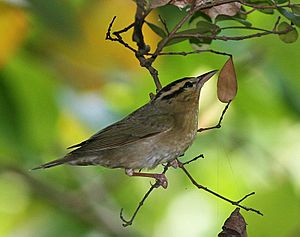Worm-eating warbler facts for kids
The worm-eating warbler (Helmitheros vermivorum) is a small bird found in the Americas. It's known for its unique head stripes. These birds spend their summers breeding in the eastern United States. When winter arrives, they fly south to warmer places like southern Mexico, the Caribbean, and Central America.
Quick facts for kids Worm-eating warbler |
|
|---|---|
 |
|
| Conservation status | |
| Scientific classification | |
| Genus: |
Helmitheros
|
| Species: |
vermivorum
|
 |
|
| Range of H. vermivorum Breeding range Winter range | |
| Synonyms | |
|
Helmitheros vermivorus |
|
Contents
Bird Classification: The Worm-Eating Warbler's Group
The worm-eating warbler is the only bird in its special group, called a genus, named Helmitheros. Another bird, Swainson's warbler, used to be in this group too, but it's now in a different one.
What Does the Worm-Eating Warbler Look Like?
The worm-eating warbler is a small New World warbler. It has a simple look with olive-brown feathers on its back and lighter feathers underneath. Its head has cool black and light brown stripes. It also has a thin, pointed beak and pink legs.
Measurements:
- Length: About 4.4 to 5.2 inches (11.2 to 13.1 cm)
- Weight: About 0.4 to 0.5 ounces (12 to 14 grams)
- Wingspan: About 7.9 to 8.7 inches (20 to 22 cm)
Younger birds have brownish stripes on their heads. Male worm-eating warblers sing a short, high-pitched trill. Their call sounds like a chip or tseet. It's hard to tell male and female worm-eating warblers apart just by looking at them. You can only really tell during their breeding season.
Reproduction and Nests
These birds build their nests in thick deciduous forests in the eastern United States. They often choose wooded slopes. Their nest is like an open cup and is placed on the ground. It's usually hidden among dead leaves.
The female bird lays four or five eggs. Both parents work together to feed their young. If a predator comes near the nest, the parents might pretend to be hurt to distract it. Sometimes, brown-headed cowbirds lay their eggs in the worm-eating warbler's nest. This happens more often when forests are broken up into smaller pieces. Keeping forests whole helps protect these warblers.
Where Do Worm-Eating Warblers Live?
Worm-eating warblers breed in the Eastern United States. The places they choose to live can be quite different. Many populations live in old hardwood forests on steep hills. However, some live near the coast.
Historically, coastal birds lived in pocosin areas, which are a type of wetland. More recently, these birds have started using pine plantations. They are even found in higher numbers in pine plantations than in what was thought to be their natural home. This shows that these warblers might care more about the structure of shrubs than how old or big the trees are.
To help these birds, it's important to manage forests so they have dense shrubs and plants close to the ground. Because they rely on shrubs for food and nest on the ground, frequent fires can harm them. Other ways of managing forests that reduce shrubs or increase open areas can also be bad for them.
When winter comes, these birds migrate to southern Mexico, the Greater Antilles, and Central America. They especially like the Caribbean Slope. There, they live in both scrubland and moist forests. Worm-eating warblers have disappeared from some areas because their homes have been lost. But their ability to use different types of forests might help them survive in the long run.
What Do Worm-Eating Warblers Eat?
The diet of worm-eating warblers changes depending on where they are. On their breeding grounds, they mostly pick arthropods (like insects and spiders) from live leaves. In their winter homes, they mostly find insects on dead plants.
The name "worm-eating" comes from the many insect larvae (like caterpillars) they eat. They almost never eat earthworms.
Using pesticides, especially over large areas, can harm these birds. Pesticides reduce the insects they eat, which is their main food source. This can also cause long-term health problems for the birds.
See also
 In Spanish: Chipe vermívoro para niños
In Spanish: Chipe vermívoro para niños


